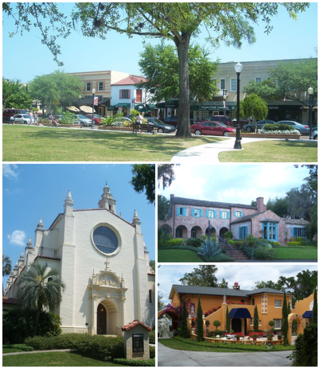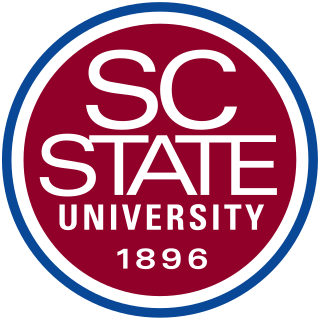
Zora Neale Hurston was an American author, anthropologist, and filmmaker. She portrayed racial struggles in the early-1900s American South and published research on hoodoo. The most popular of her four novels is Their Eyes Were Watching God, published in 1937. She also wrote more than 50 short stories, plays, and essays.

Orange County is located in the central portion of the U.S. state of Florida. As of the 2020 census, the population was 1,429,908, making it Florida's fifth most populous county. The county seat is Orlando. Orange County is the central county of the Orlando-Kissimmee-Sanford, Florida Metropolitan Statistical Area.

Eatonville is a town in Orange County, Florida, United States, six miles north of Orlando. It is part of Greater Orlando. Incorporated on August 15, 1887, it was one of the first self-governing all-black municipalities in the United States. The Eatonville Historic District and Moseley House Museum are in Eatonville. Author Zora Neale Hurston grew up in Eatonville and the area features in many of her stories.

Winter Park is a city in Orange County, Florida, United States. The population was 29,795 according to the 2020 census. It is part of the Orlando–Kissimmee–Sanford, Florida Metropolitan Statistical Area.

Bethune–Cookman University is a private historically black university in Daytona Beach, Florida. Bethune–Cookman University is affiliated with the United Methodist Church. The primary administration building, White Hall, and the Mary McLeod Bethune Home are two historic locations.

South Carolina State University is a public, historically black, land-grant university in Orangeburg, South Carolina. It is the only public, historically black land-grant institution in South Carolina, is a member-school of the Thurgood Marshall College Fund, and is accredited by the Southern Association of Colleges and Schools (SACS).

Mary Jane McLeod Bethune was an American educator, philanthropist, humanitarian, womanist, and civil rights activist. Bethune founded the National Council of Negro Women in 1935, established the organization's flagship journal Aframerican Women's Journal, and presided as president or leader for a myriad of African American women's organizations including the National Association for Colored Women and the National Youth Administration's Negro Division.

The Orlando Philharmonic Orchestra is Central Florida's resident professional orchestra, appearing in more than 125 performances each season. Founded in 1993. At over $4 million, the Orlando Philharmonic has the largest endowment of any arts institution in Central Florida. The Orlando Philharmonic entered its 29th anniversary in the 2021-2022 season, led by Eric Jacobsen in his fourth season as Music Director.

Hiwassee College was a private liberal arts college in Madisonville, Tennessee. Founded in 1849, the college offered associate degrees as well as bachelor's degrees. The majority of its associate degree graduates went on to complete bachelor's degrees elsewhere. The college closed on May 10, 2019 due to financial issues.

Orange County Public Schools (OCPS) is the public school district for Orange County, Florida. It is based in the Ronald Blocker Educational Leadership Center in downtown Orlando. As of the 2022-23 school year, OCPS has an enrollment of 208,788 students, making it the 9th largest school district in the United States and the fourth largest in Florida. The school district also employs over 24,294 instructional and classified employees, which make up more than 95% of the OCPS work force. It includes the entire county.

William Rennick Boone High School is a public high school in Orlando, Florida. Built in 1952, the school is one of twenty high schools in the Orange County Public Schools system, created to accommodate the growing number of students at Orlando High School.

Apopka High School is in Apopka in northwest Orange County, Florida, United States. The school has been named a Blue Ribbon School of Excellence.
Jones High School is located in the Parramore/Lorna Doone neighborhood in the urban heart of Orlando, Florida at 801 S. Rio Grande Avenue. It is a public school in the Orange County School District. The school mascot is the Tiger and the colors are orange and green.
The Florida education system consists of public and private schools in Florida, including the State University System of Florida (SUSF), the Florida College System (FCS), the Independent Colleges and Universities of Florida (ICUF) and other private institutions, and also secondary and primary schools as well as virtual schools.

The Florida Classic is the annual college football rivalry game between Bethune–Cookman University and Florida A&M University. The game has been televised nationally by ESPN Classic as a part of a multi-year contract with the Mid-Eastern Athletic Conference (MEAC), which had been both schools' home conference until their July 2021 departure for the Southwestern Athletic Conference (SWAC). The game is operated by Florida Citrus Sports, a non-profit group that also organizes the Cheez-It Bowl and Citrus Bowl. The Classic has approximately a $31 million impact on Orlando's economy; it was the largest MEAC conference football game before the schools left for the SWAC, and remains the largest Division I FCS football game in Florida.
Clifford Reed is an American college basketball coach who last served as the interim head coach at Maryland Eastern Shore. He is also the former head coach at Bethune–Cookman.

Joseph Nathaniel Crooms, also known as J. N. Crooms, was an African American principal and educator in Florida. He established two schools for African American students in Seminole County, the first being Hopper Academy and the second being Crooms Academy in Goldsboro, Florida, in 1926. Crooms Academy was the first four-year high school for African Americans in Seminole County, Florida.
Richard Vernon Moore Sr. was an American educator, principal, and university president. He served as the third president of Bethune-Cookman College in Daytona Beach, Florida (1947–1975). Moore was also the state of Florida's first African-American Supervisor of Secondary Schools for Negros.
Charles Phillip Bailey Sr. was a U.S. Army Air Force officer and one of the Tuskegee Airmen's most decorated combat fighter pilots. He was Florida's first African American fighter pilot. He flew 133 missions over Europe and North Africa, and was credited with shooting down two enemy aircraft.


















